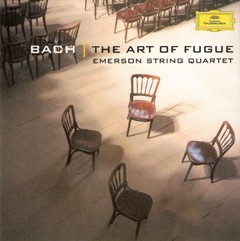111 Years of Deutsche Grammophon - CD 12
111 Years of Deutsche Grammophon - CD 12
Bach, J.S.: The Art of Fugue, BWV 1080

Version for String Quartet 1 Contrapunctus I [3:04] 2 Contrapunctus [2:44] 3 Contrapunctus 3 [2:31] 4 Contrapunctus 4 [3:30] 5 Contrapunctus 5 [2:32] 6 Contrapunctus 6 [4:10] 7 Contrapunctus 7 [3:07] Emerson String Quartet 8 Contrapunctus 8 [4:54] Eugene Drucker, Lawrence Dutton, David Finckel 9 Contrapunctus 9 [2:14] 10 Contrapunctus 10 [3:02] 11 Contrapunctus 11 [4:43] Emerson String Quartet 12 Contrapunctus 14a: Canon per Augmentationem in contrario motu [5:18] Eugene Drucker, David Finckel 13 Contrapunctus 12a [1:50] 14 Contrapunctus 12b [1:53] Emerson String Quartet 15 Canon alla Ottava [4:02] Lawrence Dutton, David Finckel 16 Canona alla Decima, in Contrapunto alla Terza [3:42] Eugene Drucker, Lawrence Dutton 17 Canon alla Duodecima in Contrapunto alla Quinta [4:13] Philip Setzer, David Finckel 18 Contrapunctus 13a [2:06] Philip Setzer, Lawrence Dutton, David Finckel 19 Contrapunctus 13b [2:09] Eugene Drucker, Lawrence Dutton, David Finckel 20 Contrapunctus 14: Canon per Augmentationem in contrario motu [6:53] Philip Setzer, David Finckel 21 Contrapunctus 14(18): Fuga a 3 Soggetti [8:06] 22 Chorale: Wenn wir in höchsten Nöten sein [3:16] Emerson String Quartet
The Art of Fugue (or The Art of the Fugue, original German: Die Kunst der Fuge), BWV 1080, is an incomplete work by Johann Sebastian Bach (1685–1750). It was most likely started at the beginning of the 1740s, if not earlier. The first known surviving version, which contained 12 fugues and 2 canons, was copied by the composer in 1745. This manuscript has a slightly different title, added afterwards by his son-in-law Johann Christoph Altnickol: Die Kunst der Fuga. Bach's second version was published in 1751 after his death. It contains 14 fugues and 4 canons. "The governing idea of the work", as the eminent Bach specialist Christoph Wolff put it, is "an exploration in depth of the contrapuntal possibilities inherent in a single musical subject."
The order of the fugues and canons has been debated, especially as there are differences between the manuscript and the printed editions appearing immediately after Bach's death. Also musical reasons have been invoked to propose different orders for later publications and/or the execution of the work, e.g. by Wolfgang Graeser in 1927, who also published his own "completion" of the final Contrapunctus XIV.
The 1751 printed edition contained — apart from a high number of errors and other flaws — a four-part version of Contrapunctus XIII, arranged to be played on two keyboards (rectus BWV 1080/18,1 and inversus BWV 1080/18,2). It is however doubtful whether the printed indication "a 2 Clav.", and the fourth added voice, that is not mirrored according to Bach's usual practice, derive from him, or from his son(s) that supervised this first edition.
The engraving of the copper plates for the printed edition would however have started shortly before the composer's death, according to contemporary sources, but it is unlikely that Bach had any real supervision in that preparation of the printed edition, due to his illness at the time.
The first printed edition also includes an unrelated work as a kind of "encore", the chorale prelude Vor deinen Thron tret Ich hiermit (Herewith I come before Thy Throne), BWV 668a, which Bach is said to have dictated on his deathbed.
A 1742 fair copy manuscript contains Contrapuncti I–III, V–IX, and XI–XIII, plus the octave and augmented canons and an earlier version of Contrapunctus X.








